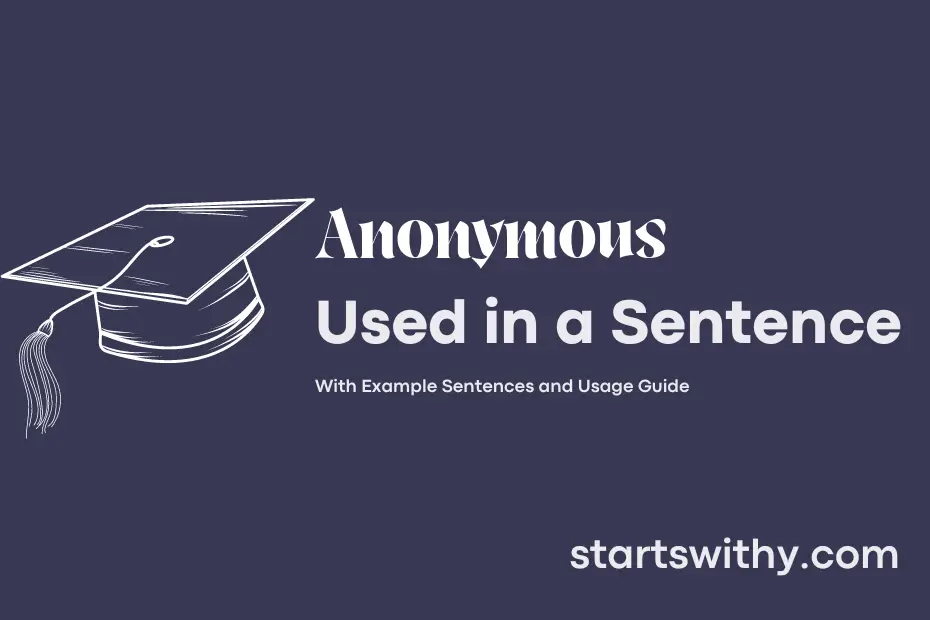Have you ever wondered what it means to write an anonymous sentence? When a sentence is considered anonymous, it means that the author’s identity is intentionally concealed or unknown. In other words, the words are shared without revealing who originally penned them.
An anonymous sentence can be a powerful tool for sharing ideas without the burden of personal attribution. By removing the focus on the author, the words themselves carry greater weight and impact, allowing the reader to fully engage with the message being conveyed.
7 Examples Of Anonymous Used In a Sentence For Kids
- Anonymous means keeping your name hidden.
- Sometimes people want to remain anonymous when they do something nice for others.
- The person who sent us this gift card wishes to stay anonymous.
- Can you guess who wrote this anonymous letter?
- It’s okay to be anonymous if you feel shy about sharing your idea.
- Anonymous donations are gifts given without revealing who the giver is.
- Do you know what it means to be anonymous?
14 Sentences with Anonymous Examples
- Anonymous feedback forms are a common practice in colleges to gather honest opinions from students.
- It is important to respect the confidentiality of anonymous donors who contribute to college scholarships.
- Many college students prefer seeking advice from anonymous online forums for academic help.
- Anonymous surveys are often conducted by college committees to make informed decisions about campus improvements.
- Students can report incidents of bullying or harassment through anonymous tip lines provided by colleges.
- Anonymous voting for student council elections ensures a fair and unbiased selection process.
- College professors may use anonymous grading to maintain objectivity while assessing students’ work.
- Some colleges offer anonymous mental health helplines for students in need of support.
- Sharing anonymous study notes and resources can be beneficial for collaboration among college peers.
- Anonymous peer feedback is encouraged during group projects to promote constructive criticism and growth.
- Students can submit anonymous complaints about campus facilities or services to the college administration.
- College bloggers may choose to write anonymous posts to express their opinions without revealing their identity.
- Participating in anonymous online quizzes and polls can be a fun way for college students to engage with current events.
- Students can enjoy anonymous browsing on college computers to maintain privacy while conducting research.
How To Use Anonymous in Sentences?
Anonymous means without revealing one’s identity. It is used when the person’s name or details are kept secret.
Here’s a sentence using Anonymous:
– She received a love letter from an anonymous admirer.
To use Anonymous in a sentence correctly, remember to place it before the noun it describes. You can also use it as a subject or object in a sentence.
Example sentences:
– An anonymous donor contributed $1,000 to the charity.
– The company received an anonymous tip about a potential security threat.
Remember, Anonymous is an adjective, so it describes a noun. It adds a sense of mystery or secrecy to the person or thing being described.
Now that you know how to use Anonymous in a sentence, feel free to incorporate it into your writing to add intrigue or suspense.
Conclusion
In conclusion, the concept of anonymous sentences refers to those that lack identifiable information about the author. These types of statements are often used to protect the writer’s identity or to allow for open sharing of opinions without fear of repercussions. Anonymous sentences can be found in various contexts, such as online forums, whistleblowing reports, or anonymous feedback forms.
Despite the anonymity of these sentences, they can still hold valuable insights or critical feedback. However, it’s crucial to carefully consider the credibility and intent behind anonymous statements before drawing conclusions or taking action. Anonymity can offer a veil of protection and freedom for expression, but it also requires a discerning approach to ensure that the information provided is taken with appropriate caution and scrutiny.



